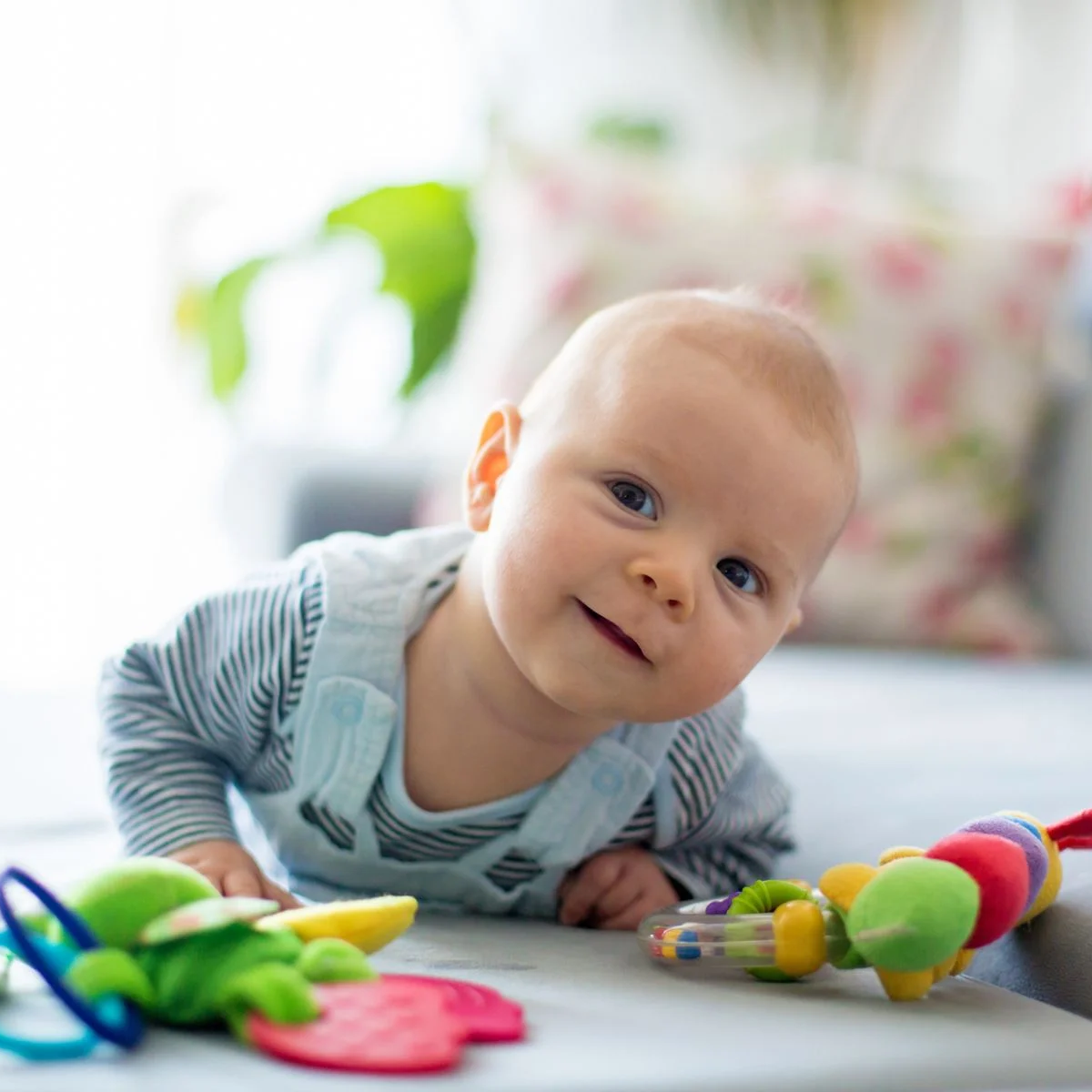Physical play, which even begins in the first months, mainly contributes to the growth and development of gross motor functions such as control of limbs, trunk, and head. It helps. In the first and second months after birth, the child is interested in muscular activities such as kicking, turning over, rolling, waving hands, and other well-known bodily movements. At one month old, the child touches the rattle and quickly throws it. Around two and a half months, the child can shake the rattle, and one of their entertainments is producing various sounds from the larynx. From about two or three months, exploratory play begins, which takes the form of playing with fingers. From one to four months, the child discovers sounds and colors.
It helps. In the first and second months after birth, the child is interested in muscular activities such as kicking, turning over, rolling, waving hands, and other well-known bodily movements. At one month old, the child touches the rattle and quickly throws it. Around two and a half months, the child can shake the rattle, and one of their entertainments is producing various sounds from the larynx. From about two or three months, exploratory play begins, which takes the form of playing with fingers. From one to four months, the child discovers sounds and colors.
A child will look at a toy only if it is placed within their view. From three months onwards, their interest in toys becomes stronger. Therefore, they try to pull the toy toward themselves by moving both hands and to make contact with it. At this age, a moving object can be hung over the child’s crib, and colorful images can be placed in their room.
Gently move a rattle or toy beside the child’s eyes so that their eyes follow the movement of the toy. Allow the child to grasp, shake, and make noise with an object (such as a rattle or plastic cup) that is in their hands. This activity entertains the child.
At four and a half months, the child picks up everything they see and is within reach, brings it to their mouth, sucks, shakes, and throws it. Provide various objects (like pieces and cups) for the child to grasp. Since the child likely wants to put these objects in their mouth, make sure beforehand that they are the right size and clean, so they cannot be swallowed. By shaking a rattle behind the child, encourage them to turn around and grab it.
At five months, examining toys with the eyes, staring at the hands, and increasing vocal movements bring fun and enjoyment to the child. When a block is given to the child, they happily grasp it.
In the sixth month, laughing, throwing toys and enjoying the sound of them hitting the ground, and pulling toys towards themselves if they are tied to a string, delight the child. At this age, the child can entertain themselves with their toys for five to ten minutes and can also transfer objects from one hand to the other. They have a strong desire to touch everything and want to put everything in their mouth. They explore toys by looking, touching, mouthing, and banging them on the ground. Therefore, allow the child to play with common household items such as plates, pots, spoons, newspapers, cloths, and similar objects. They also hide their face by pulling a sheet over it and then move it aside.
At seven months, playing with objects around the environment, crumpling paper, playing with a spoon and cup, taking off a hat, pulling down their own socks, playing with water, laughing, waving hands, and shouting in front of familiar people, as well as turning the head to hide and play, are types of play at this age. The child at this age can transfer toys from one hand to the other, drop toys and watch where they fall; move toys on surfaces that make sounds, and prefers toys that move and make noise. Attach a toy with a piece of string so the child can pull it across the room, table, or bed.
At seven months, the child puts their hand under running water and enjoys the feeling of water flowing over it.
Imitative play, such as imitating the mother’s voice or other caregivers’ sounds, is clearly observable between seven to eight months. Talk to the child and imitate their sounds, especially when feeding or changing their clothes. Talk about food and clothing with them. For example, say: “Now I’m buttoning your shirt.” Talk about the pictures they see. Avoid using baby talk. When the child speaks, look directly at them. Use complete and correct sentences. Use play activities that involve word games. Repeat simple words like “hello,” “dada,” and so on.
At eight months, the child chooses the toy they like among the toys. If something falls out of the cradle, they pull themselves toward it.
Between eight to eleven months, the child actively searches for toys that are hidden from their view and removes obstacles to reach them. At eight months, the child throws their toys, which they consider a form of play. Another type of play is banging two objects, two blocks, or two toys together.
Between eight to twelve months, throwing objects more and farther is a child’s favorite activity. Therefore, provide them with unbreakable toys. Place wind-up toys on their small dining table. A dancing bear or a turtle that shakes its head can make the child laugh until they cry. Dolls that can be twisted into any shape will also make the child happy. During bath time, use floating animals like goldfish, ducks, whales, or frogs.
At nine to ten months, if another child tries to take their toy, the child resists. At nine months, if a string is attached to a toy, the child pulls it toward themselves. If an object is hidden, they become curious and try to find it. Between eight to nine months, the child gives their toy to other children.
At ten months old, the child gains better control over motor nerves, stands, and grasps toys. If a toy is hidden under a cover in front of their eyes, they will go and retrieve it. During this period, the child tries to explore and discover the surrounding world. They grasp objects, rotate them frequently, hold them between their fingers, and often bring them to their mouth. They enjoy banging the object they hold against something. At this age, the child likes to break things into pieces and enjoys putting one object inside another. They put objects into a box and take them out again. They play by flapping their hands like bird wings. If they hold one toy but are given another, they try to hold both toys in one hand.
At the age of ten to twelve months, the child holds a pencil.
A child at eleven to twelve months old can pull toy cars or wooden toys tied to a string toward themselves. They are interested in small objects like buttons, glass eyes, and holes. They enjoy interactive games such as peekaboo, hiding objects, and chasing games.
At one year old, children enjoy wind-up toys that move and make noise, and these toys attract their attention. They also pay attention to birds, animals, vehicles, and moving objects. You can sit the child down and introduce them to playing with a ball by rolling it.
A child up to the age of one plays with any object available to them and examines it in several ways—by its texture (rough or soft), taste, sound, and similar aspects. For children of this age, rattles, dolls, and soft rings that are easy to clean are very suitable.
A child who is just beginning to walk is interested in objects they can interact with, not just observe or touch. Colorful plastic bowls, a cuddly doll, a bright balloon, a colorful ball, and toys like a baby walker that the child can push forward are among the favorites at this age.
At one year old, a child needs toys such as balls, building blocks, pull-along animals or cars, cups and hollow cubes that can be nested inside one another or stacked.
Toys from birth to one year should be lightweight and make sounds. At one year, children enjoy wind-up toys that move and make noises, which attract their attention.
The following toys are recommended for children aged 1 to 12 months: rattles, cloth dolls, plastic rings, wooden cubes, colorful balls, baby walkers, colorful balloons, colorful plastic bowls and various sizes of cups, colorful measuring cups, large building blocks, hollow cubes, sound-making toys (tambourines, drums, etc.), wind-up toys, floating toys for water play (like fish, plastic ducks, etc.), cars, carts, and animals that can be pulled with a string, as well as ordinary household items like plates, pots, spoons, cups, etc.
media: پرتال جامع علوم انسانی






